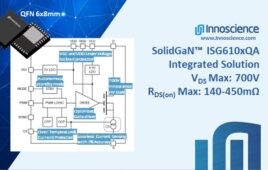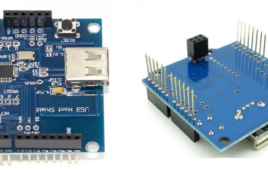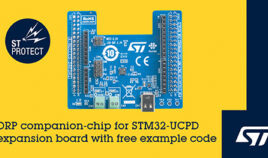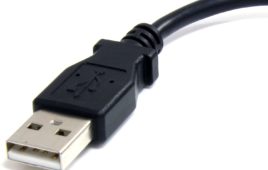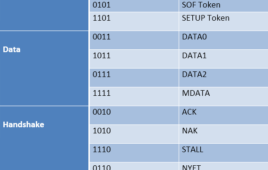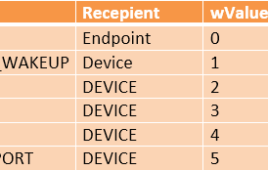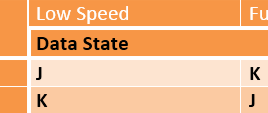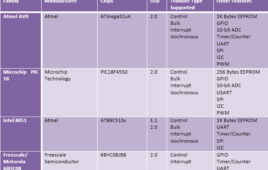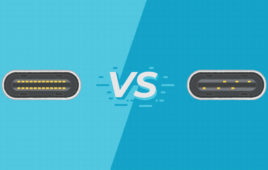Innoscience announced a family of four new integrated devices that combine power GaN HEMT, driver, current sense, and other functions within a single, industry-standard QFN 6x8mm package. The 700V ISG610x SolidGaN devices cover the range from 140mΩ to 450mΩ and save PCB space and BOM count while increasing efficiency and simplifying design for applications including…
How to read input from USB keyboard on Arduino
Generally, Arduino boards can only serve as USB slaves. They cannot operate as USB hosts. That is why it is impossible to connect USB devices like a USB keyboard or mouse directly to Arduino. These generic USB devices can be a lot useful in many applications. For example, in some applications, a 4X4 keypad might…
STMicroelectronics offers port-protection IC for STM32 MCUs with USB-C dual-role power
STMicroelectronics‘ TCPP03-M20 USB Type-C port-protection IC is tailored for dual-role power (DRP) applications, simplifying the design of products that can act as a power source for connected devices, as well as accepting power from other USB-C sources. When used as a companion chip with STM32G0*, STM32G4, STM32L5, and STM32U5 microcontrollers that contain ST’s UCPD (USB…
Introduction to USB: Advantages, Disadvantages and Architecture (Part 1/6)
Universal Serial Bus (USB) is the de facto interface for computer peripherals to communicate with the personal computers. The interface that saw the light of day around the mid-1990s was a joint effort of seven companies – Compaq, DEC, IBM, Intel, Microsoft, Nortel, and NEC.
USB Protocol: Types of USB Packets and USB Transfers (Part 2/6)
After discussing the features and architecture of USB, let’s move on to its protocol. A USB interface has several layers of protocol. Most of the time the lower level layers are single handled by host controller IC while the end designer needs to work on higher level layers. Every communication protocol involves the exchange of packets. Same is the case with USB. These packets encapsulate information in a standard-defined organized manner. These packets generally contain information related to- Controlling the data exchange, Data exchange in the form of actual payload, and Error detection and correction through the status check up. In USB the LSB of the packet is transmitted first. A USB packet contains different fields.
USB Requests and Stages of Control Transfer (Part 4/6)
In the previous article of this series, USB Descriptors were discussed. When a USB peripheral is connected to a host device, the host sends queries in the form of requests. The peripheral responds by sending Descriptors. The Descriptors contain the information required for identifying and configuring the peripheral device, implementing the interfaces and setting endpoints. The device descriptor is the first descriptor sent to the host and it helps in configuring the peripheral with respect to the host. The subsequent descriptors implement the functioning, the peripheral is meant for. The Control Transfer is the only transfer type which is supported even when the device is yet not configured. That is the reason, it is used for sending requests and obtaining the descriptors. The default endpoint is endpoint 0 which is bidirectional and used for control transfers.
Introduction to USB: Advantages, Disadvantages and Architecture (Part 1/6)
Universal Serial Bus (USB) is the de facto interface for computer peripherals to communicate with the personal computers. The interface that saw the light of day around the mid-1990s was a joint effort of seven companies – Compaq, DEC, IBM, Intel, Microsoft, Nortel, and NEC. These companies were aiming to replace the then parallel ports and the external power chargers with a universal communication standard that could simplify data exchange and could double duty to supply power as well.Nowadays, USB is the standard and must-have interface on almost all motherboards, single board computers and the embedded microcontroller boards and almost every digital peripheral from regular computer peripherals like keyboard, mouse and joysticks to smart digital devices.
USB Descriptors and their Types (Part 3/6)
Now that we have discussed the basic details of USB including its features, architecture, and protocol, the next topic in the series is USB Descriptors. In context to USB interface, Descriptors are formatted blocks of information, through which, the host device learns about the peripheral. It helps in identifying and configuring the peripheral device.A Descriptor contains information like type of the device, Vendor ID, Compliant USB Version, number of configurations device supports, number of endpoints, etc. The USB peripheral must respond with descriptors when requested by the host. During enumeration, the host uses control transfer to request the device for descriptors.
USB Requests and Stages of Control Transfer (Part 4/6)
In the previous article of this series, USB Descriptors were discussed. When a USB peripheral is connected to a host device, the host sends queries in the form of requests. The peripheral responds by sending Descriptors. The Descriptors contain the information required for identifying and configuring the peripheral device, implementing the interfaces and setting endpoints. The device descriptor is the first descriptor sent to the host and it helps in configuring the peripheral with respect to the host. The subsequent descriptors implement the functioning, the peripheral is meant for. The Control Transfer is the only transfer type which is supported even when the device is yet not configured. That is the reason, it is used for sending requests and obtaining the descriptors. The default endpoint is endpoint 0 which is bidirectional and used for control transfers.
Signal and Encoding of USB System (Part 5/6)
In this series, USB requests and descriptors have been already discussed. With the knowledge of USB requests, descriptors, transfer types and transactions it is now easy to understand how data is communicated over USB interface. Another aspect of the USB communication is line states and encoding, which is generally ignored by the system designers as a USB device can be designed without knowing the Signaling and Encoding schemes. The signaling and encoding schemes are implemented at the lower levels (usually on the controller IC) and usually gets abstracted during system designing. However, understanding the terms related to bus states and encoding would help in getting comprehensive view of the USB System.
Controller Chip Selection for Developing USB Enabled Device (Part 6/6)
In this series, every possible detail about the USB system including its architecture, protocols, requests and descriptors as well as signaling and encoding has been already discussed. Wrapping up the series, selection of the controller chip for the development of a USB enabled device is discussed here.
A look at USB Type-C in power-only applications
Having been around for more than two decades, USB connectors are one of the most popular and well-recognized interconnect components in electronic designs. From Type A to Type-C, USB has gone through an array of changes both in terms of the physical connector as well as their associated standards. USB Type-C is the most advanced…

